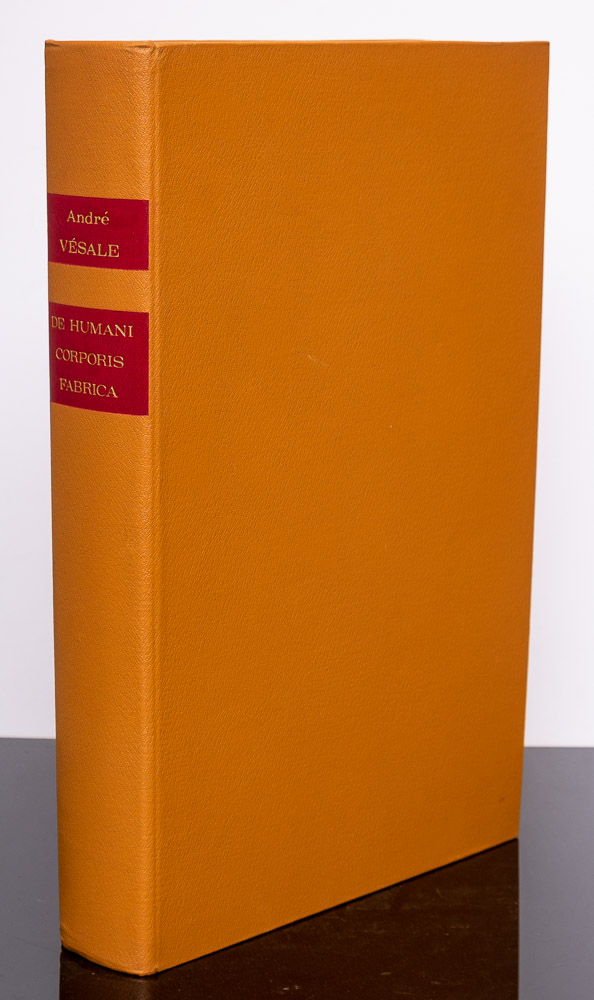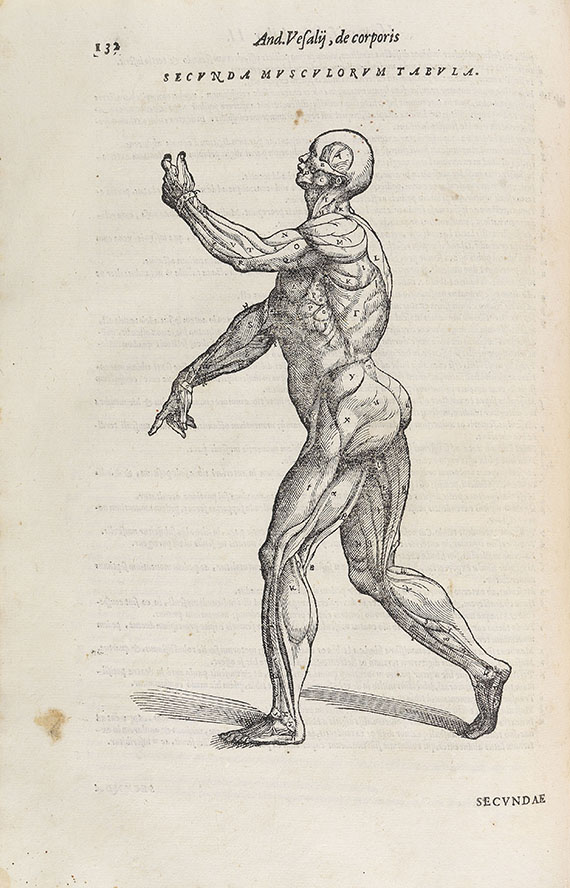VESALIUS, Andreas (1514-1564). De humani corporis fabrica libri septem . Basel: Johannes Oporinus, June 1543.
VESALIUS, Andreas (1514-1564). De humani corporis fabrica libri septem . Basel: Johannes Oporinus, June 1543. Royal 2° (427 x 282mm). Roman, italic, Hebrew and Greek types. With the two folding sheets following m2 and p3, but without the single leaf inserted in quire m ('Charta parvas aliquot figuras complectens'). Woodcut pictorial title, author portrait, over 200 woodcut illustrations, including 3 full-page skeletons and 14 full-page muscle-men, printer's device at end, and many woodcut historiated and ornamental initials from several sets. (Title with a few, light creases and minor repairs, faint dust-soiling on first and last page, two-three marginal wormholes in first c.100 leaves, small wormtrack at guard of folding plate m3, very occasional small, light spot.) Contemporary German blindtooled pigskin over wooden boards, including a David-Mary-Jesias roll with initials 'MR' and dated 1546 [not in Einbanddatenbank], two fore-edge clasps, endpapers with Tower watermark [similar, but not identical, to Piccard Turm XVII 351-354, localised to Freiberg/Goslar/Weimar/Magdeburg 1545-63] (small repair at head of spine, small stain); modern brown morocco folding box. AN EXCEPTIONALLY TALL, FRESH COPY, OF 'THE MOST FAMOUS ANATOMICAL WORK EVER PUBLISHED, ... AND THE MILESTONE IN ALL MEDICAL HISTORY' ( Heirs of Hippocrates ). The Fabrica is 'a complete anatomical and physiological study of every part of the human body ... [dealing] with bones and muscles, blood vessels, nerves, abdominal viscera, thoracic organs and the brain' (PMM). Benefitting from the then-radical practice of dissecting the human body rather than animals, Vesalius broke new ground in his method and observations, thus fundamentally dividing the study of anatomy into pre- and post-Vesalian periods. The Fabrica is widely considered the most beautiful medical book ever published. It combines scientific exposition, art and typography in a manner unprecedented in the 16th century and rarely equalled in later centuries. The more than 200 woodblocks for the illustrations were prepared in Venice by an anonymous artist in the school of Titian under Vesalius's supervision and shipped to the publisher in Basel with the author's precise instructions for placing them in relation to the text and for keying explanations printed in the margins to particular illustrations or details. The woodcuts were highly influential and were re-used or copied for over a century; the woodblocks themselves survived in Germany up to the Second World War. The work opens with a full-page scene of an anatomical theatre showing the dissection of a female corpse in progress; Vesalius performed one of the earliest autopsies on a female body. The 14 muscle-men stand in landscapes that together form a panorama of the Euganean Hills near Padua, where Vesalius studied and wrote his magnum opus , and even the woodcut initials, cut specially for this edition, depict activities associated with the dissecting room. The present copy is taller even than the Norman copy, presented to the dedicatee, Holy Roman Emperor Charles V. That copy too was originally missing the fugitive single leaf in quire m which contains small woodcuts intended to be cut out and attached as overlays to the large folding skeletons. Adams V-603; Dibner, Heralds of Science 122; Garrison-Morton 375; Heirs of Hippocrates 281; Grolier Medicine 18A; NLM/Durling 4577; PMM 71; Wellcome 6560; Norman 2137.
VESALIUS, Andreas (1514-1564). De humani corporis fabrica libri septem . Basel: Johannes Oporinus, June 1543.
VESALIUS, Andreas (1514-1564). De humani corporis fabrica libri septem . Basel: Johannes Oporinus, June 1543. Royal 2° (427 x 282mm). Roman, italic, Hebrew and Greek types. With the two folding sheets following m2 and p3, but without the single leaf inserted in quire m ('Charta parvas aliquot figuras complectens'). Woodcut pictorial title, author portrait, over 200 woodcut illustrations, including 3 full-page skeletons and 14 full-page muscle-men, printer's device at end, and many woodcut historiated and ornamental initials from several sets. (Title with a few, light creases and minor repairs, faint dust-soiling on first and last page, two-three marginal wormholes in first c.100 leaves, small wormtrack at guard of folding plate m3, very occasional small, light spot.) Contemporary German blindtooled pigskin over wooden boards, including a David-Mary-Jesias roll with initials 'MR' and dated 1546 [not in Einbanddatenbank], two fore-edge clasps, endpapers with Tower watermark [similar, but not identical, to Piccard Turm XVII 351-354, localised to Freiberg/Goslar/Weimar/Magdeburg 1545-63] (small repair at head of spine, small stain); modern brown morocco folding box. AN EXCEPTIONALLY TALL, FRESH COPY, OF 'THE MOST FAMOUS ANATOMICAL WORK EVER PUBLISHED, ... AND THE MILESTONE IN ALL MEDICAL HISTORY' ( Heirs of Hippocrates ). The Fabrica is 'a complete anatomical and physiological study of every part of the human body ... [dealing] with bones and muscles, blood vessels, nerves, abdominal viscera, thoracic organs and the brain' (PMM). Benefitting from the then-radical practice of dissecting the human body rather than animals, Vesalius broke new ground in his method and observations, thus fundamentally dividing the study of anatomy into pre- and post-Vesalian periods. The Fabrica is widely considered the most beautiful medical book ever published. It combines scientific exposition, art and typography in a manner unprecedented in the 16th century and rarely equalled in later centuries. The more than 200 woodblocks for the illustrations were prepared in Venice by an anonymous artist in the school of Titian under Vesalius's supervision and shipped to the publisher in Basel with the author's precise instructions for placing them in relation to the text and for keying explanations printed in the margins to particular illustrations or details. The woodcuts were highly influential and were re-used or copied for over a century; the woodblocks themselves survived in Germany up to the Second World War. The work opens with a full-page scene of an anatomical theatre showing the dissection of a female corpse in progress; Vesalius performed one of the earliest autopsies on a female body. The 14 muscle-men stand in landscapes that together form a panorama of the Euganean Hills near Padua, where Vesalius studied and wrote his magnum opus , and even the woodcut initials, cut specially for this edition, depict activities associated with the dissecting room. The present copy is taller even than the Norman copy, presented to the dedicatee, Holy Roman Emperor Charles V. That copy too was originally missing the fugitive single leaf in quire m which contains small woodcuts intended to be cut out and attached as overlays to the large folding skeletons. Adams V-603; Dibner, Heralds of Science 122; Garrison-Morton 375; Heirs of Hippocrates 281; Grolier Medicine 18A; NLM/Durling 4577; PMM 71; Wellcome 6560; Norman 2137.















Testen Sie LotSearch und seine Premium-Features 7 Tage - ohne Kosten!
Lassen Sie sich automatisch über neue Objekte in kommenden Auktionen benachrichtigen.
Suchauftrag anlegen